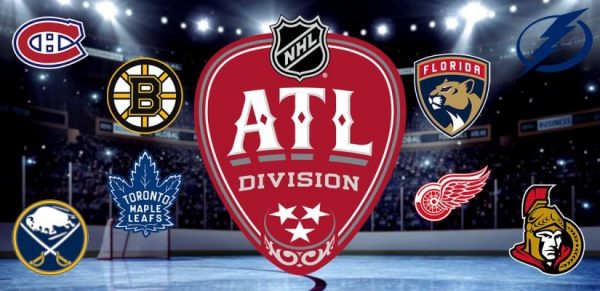
By: Ross Matthews | Follow me @RossFromNewton
After last season’s bespoke divisional alignment and 56 game schedule, the NHL will return to the familiar divisions and 82 game regular season schedule in 2021-22. In the East, the Atlantic (BOS, BUF, DET, FLA, MTL, OTT, TBL, TOR) and the Metropolitan (CAR, CBJ, NJD, NYI, NYR, PHI, PIT, WSH) will each produce three guaranteed playoff seeds in the same bracket. The two teams with the most points that fail to be in the top 3 of their division will be wildcard seeds destined to join their respective 1/8 or 2/7 first-round matchup opponent’s divisional bracket.
You might be wondering what does this mean for the Bruins? This season it means more likely than not, the Bruins’ possible road to the Cup will run through the sunshine state – at least once and likely twice.
While the NHL schedule has many quirks – I will not bore you with most of them – it is essential for every fan to know that since the 2004-05 NHL entire season lockout, the league and players agreed to an “every team in every arena” schedule format. This is without question important for the branding of the athletes, growth of the game, and generational fan hoods – however, it does not leave much extra space in the regular season for heightened rivalries.
The Bruins will still only play most of these divisional teams twice at home and twice on the road.
Fortunately, the playoff format does offer that opportunity for heightened divisional rivalries. After a unique 2020-21 season, all Bruins fans need to catch up on the who’s who of the Atlantic now more than ever heading into the opener VS Dallas on October 16th.
Buffalo Sabres (2020-21 15-34-7, 37 points, 31st in NHL)
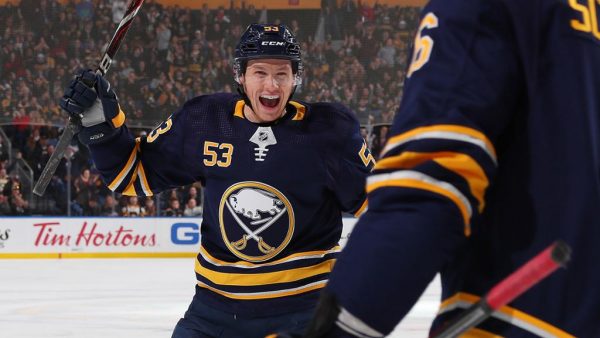
2021-22 Projection: 8th place in the Atlantic
There are two words to most succinctly describe the Buffalo Sabres’ franchise at the moment: Dumpster Fire. The ongoing dispute with generational Center and North Chelmsford native son, Jack Eichel, is perhaps the best-case study in how broken the Sabres franchise is now. The Eichel Saga could be its own topic for its own blog. What you need to know about this season is that he won’t be playing for the Sabres or in the division any time soon.
Head Coach Don Granato has his work cut out for him this year. It is more likely than not he doesn’t survive the season behind this club’s bench.
With that said, the Sabres are most interesting to a Bruins fan this year for their potential trade deadline talents than to evaluate one of the four matchups between the clubs. As currently constituted, the Bruins have just under $1.7M of available cap space. It is critical to understand any midseason or deadline trades of significance the Bruins make this year will require two-way exchanges of cap money.
Many Sabres will likely find new homes before this year’s deadline passes. For the Bruins and for the purpose of this blog, we’ll focus on two potential fits on the 21-22 Sabres – RW Tage Thompson and left-shot D Will Butcher.
Thompson is signed through the 2022-23 season at a reasonable cap hit of $1.6M. He is a moose. The UConn and USNTDP product stands at 6’7″ 219lbs. He is just 23 years old and has some serious upside with his size and projected skill. Skating remains an area of his game that must improve for him to reach his potential. Bruins’ fans will hope to see some added bite to his game in this pivotal year for him before getting too excited about Thompson playing on Causeway. Keep an eye out for big #72 in blue and yellow.
Will Butcher is a former Hobey Baker award-winning Defenseman from the University of Denver. Butcher has underwhelmed in his four NHL seasons to date. He is by no means a game-changer for the Bs or even a necessarily desirable asset – however, depending on the health, role, and performance of Bruins puck-moving left-shot blue-liners Matt Grzelcyk and Mike Reilly – Butcher could be a decent upside and favorable salary swap for either down the road.
Detroit Red Wings (2020-21 19-27-10, 48 points, t28th in NHL)
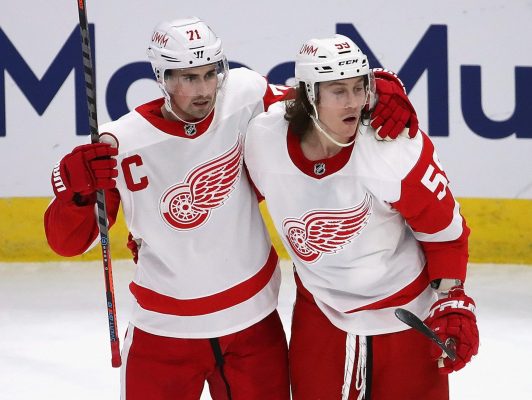
2021-22 Projection: 7th place in the Atlantic Division
From a complete outside perspective, the 2021-22 Wings may seem like a Sabres-esque wasteland – but they’re not. Stevey Y’s bunch brings significantly more young talent, organizational stability, and of course, the Hall of Famer and former architect of the Tampa Bay Lightning in the front office.
Head Coach Jeff Blashill enters his seventh season behind the spoked wheel bench after spending the prior four within the organization (2011-12 asst with Wings; 2012-14 head of AHL Grand Rapids Griffins). Despite five consecutive years missing the playoffs, Blashill is not under the gun in Detroit yet. He took the job with the entire organization aware of a needed rebuild after the close of the Datsyuk / Lidstrom / Zetterberg run.
Upfront, the Wings have a young mix of skill and grit. The first line is built around captain speedster Dylan Larkin (keep an eye on Larkin for Team USA in Beijing), with scrappy winger Tyler Bertuzzi on the left and 21-year-old uber-talented Czech winger Filip Zadina. Larkin is a legit all-star.
Bertuzzi, I love. To me, he is what Jake DeBrusk chooses not to be: a reasonable high pick (58th vs. DeBrusk at 13th) with some skill/finish, good speed but not a phenomenal skater, and the next element that JD fails to incorporate into his repertoire – he’s a rat. Bertuzzi is never far from the action, and his Spittin’ Chiclets logo-esque grin shows he’s willing to pay the price (unlike JD!). Bertuzzi has turned in back-to-back 47- and 48-point seasons with an even mix of goals and assists.
Zadina, the sixth pick in the 2018 draft, flashed at times last year but is yet to put together the type of consistency needed to be the point-per-game player he projects to be. He is just 21 and certainly a player to keep an eye on this season.
The rest of the Wings forward group leaves a lot to be desired with a general mix of run-of-the-mill former legit players past their primes (Bobby Ryan, Vlad Namestnikov, Sam Gagner) and a collection of bottom-six energy guys. Not too much to elaborate on.
Defensively the Wings are similar. Danny DeKeyser has been a long-time steady presence on the blue line but lacks any significant upside as he enters the final year of his $5M cap hit (disqualifying him as a logical Bruins deadline pickup). DeKeyser will most likely play alongside Filip Hronek, eating top pair minutes and matchups. Hronek, just 23, is something like what we want Jakub Zboril to be – a smooth-skating, competent puck-moving, a defensive defenseman with real upside to prove he will play a long NHL career.
The second pairing features smooth-skating, “steady Leddy” veteran Nick Leddy ($5.5M final year – again disqualified from Bruins deadline prospects most likely) paired with 20-year-old former #6 overall pick in the 2019 draft Moritz Seider. German-born Seider is a compelling prospect at 6’3 207lbs. It will be interesting to see if he can stick it out with the big club for 82 or ends up playing in Grand Rapids. If you catch a Wings game, keep an eye out on this kid.
In net, the Wings will lean on UFA acquisition and Linus Ullmark comparable goaltender Alex “Ned” Nedeljkovic. Yzerman’s navigation of free agency and contract negotiations to land Ned was remarkable… but I’ve already remarked too much on a less than compelling divisional opponent.
Ottawa Senators (2020-21 23-28-5, 51 points, 23rd in NHL)
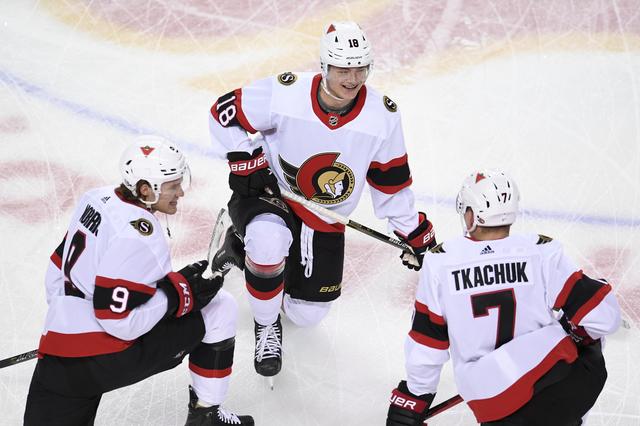
2021-22 Projection: 6th place in the Atlantic Division
Ottawa is where Detroit hopes to be within the next two to three years. The youth movement in Ottawa has been underway for several years now under Head Coach DJ Smith and is hoping to make their first legit push for the playoffs. I think they have a real shot and will be a competitive team right down to the last weeks of the season.
Last season in the exclusively Canadian (Chris Berman voice) “Norris” division, the Sens gave most teams about all they could handle for much of the shortened 56 game schedule but faded down the stretch under very reasonable circumstances to fade.
Stud young guns Brady Tkachuk, Tim “Jimmy” Stutzle, Josh Norris, and rookie former North Dakota and USA World Junior Championship standout Shane Pinto represent the team’s promising core upfront for, they hope, the next decade.
Tkachuk’s leadership has already shined through at just 22. He has the size, physicality, skill, and intangibles; it seems to be a very similar player to his father Keith over a lengthy career. If Ottawa can hang onto Tkachuk for the long term, he will become a household name for every Bruins fan.
Stutzle is an elite talent that may explode for a point-per-game or better All-Star type breakout season. He looks like almost a sure thing to be the next generation of elite point producers. He is just 19 years old.
Norris brings more playmaking from the Center position and looked to mesh extremely well with his linemates at times last year.
Rookie Shane Pinto will be on the Calder Trophy watch list. He was a better than a point-per-game player his last year at North Dakota and a standout for the USA in the World Junior Championships.
Whether the Sens keep Tkachuk or not, these three could be the next Alfredsson / Hossa / Spezza for those of you over thirty.
The rest of the forward group are a solid mix of gritty, play in any scenario, versatile role players that every playoff team needs. If the Sens don’t put it all together and are out by the deadline, several of Connor Brown ($3.6M), Chris Tierney ($3.5M), Zach Sanford ($2M), Austin Watson ($1.5M), and Tyler Ennis ($900k) are packing their bags in February.
On Defense, like many things looking forward for any Bruins die-hard, it starts and ends with the 2015 NHL Draft. Thomas Chabot, selected following the Bruins 13-14-15 strikeout right after Barzal and Kyle Connor (SMH), is an elite offensive defenseman. He’ll compete for the Norris and will always be a player to keep an eye on.
Prized prospect Erik Brannstrom, the jewel of the Mark Stone trade, will be an exciting player to follow. If Brannstrom develops, the Senators could have two of the league’s top-scoring defensemen for a long time.
The rest of the Ottawa D corps (Artem Zub, Michael Del Zotto, Nikita Zaitsev, Nick Holden) are a mish-mash of reclamation projects, middling role players, and JAGs (just a guy). Defense play should be the biggest weakness for this year’s team, and I project the primary reason they will be on the outside looking in at the playoffs.
Goaltending is unremarkable with former lightning-in-a-bottle-catching Penguin Matt Murray and Anton Forsberg. Goaltending is another weakness here, and whether it is Murray or Forsberg – quality goaltending would be the key to a Sens surprise playoff birth.
Montreal Canadiens (2020-21 24-21-11, 59 points, 18th in NHL)
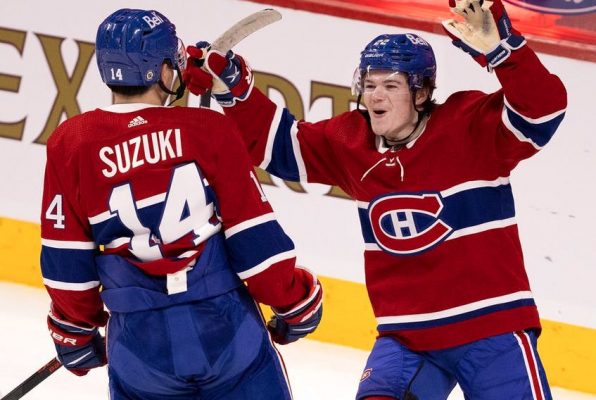
2021-22 Projection: 4th place in the Atlantic Division
The Habs. Oh, the Habs. Last season’s playoff Cinderella has had a lot of turnovers this off-season. The jury is still out on how the new mix will mesh. Until this past Summer, the past few years have been a beautiful schadenfreude for the Gallery Gods. The fortunes of the French-speaking franchise seemed to have taken a turn for the worst in the Summer of 2016 when GM Marc Bergevin traded dynamic franchise defenseman PK Subban, then 27, to the Nashville Predators for future Hall of Famer Shea Weber, then 30.
The league has been getting younger, faster, more skilled, and decidedly more offensive since the 2004-05 lockout. Subban, personifying many traits of the newer, more youthful, faster, flashier, and decidedly less honorable youth movement, was coming fresh off what felt like his first Norris trophy of several to come. Weber, on the other hand, was the best of his breed in the NHL – a dying breed of hard, heavy, honest if less fleet of foot blue liners. At the time, it was a head-scratcher and, at least for this Bruins fan, a relief. In the years since, both players have struggled. Weber with injuries. Subban with performance.
Five years later, it seems that blockbuster wasn’t as big of a deal as it appeared at the time. The trade’s historic significance may have lost some shine, but it was a symbolic signal of GM Marc Bergevin’ s team-building philosophy – against the grain going heavy over speedy.
Les Habitants’ loose cannon GM Marc Bergevin seems to be managing for his job every season up north. Even after last year’s Cinderella run, the same may be true for Bergevin this season.
Offseason additions of Christian Dvorak, David Savard, Mike Hoffman, Mathieu Perreault, Cedric Paquette, and Chris Wideman on paper seem to more than makeup for the departures of prized Quebecois shut down center Phillip Danault, former Hart Trophy award winner turned fourth line playoff lucky charm Corey Perry, and the highly skilled yet playoff healthy scratched winger Tomas Tatar.
However, every player new to Montreal responds to the rabid local press and fanbase differently. Hoffman will start the year on the injury list, as will Perreault and Paquette. When in the lineup, Hoffman is a just-shy-of-elite sniper who may bring a much-needed boost to Montreal’s lethargic powerplay. Perreault is a middling playmaker that could add scoring depth. Paquette, if you remember his years in Tampa Bay, is a Maxime Lapierre-style fourth-liner – the worst but valuable when in the lineup.
David Savard is the most likely of the new faces to be unphased by his new surroundings. A sturdy defensive defenseman that is without question difficult to play against, Savard fits the mold of Montreal’s old-school roster-building – very similar to his expected D partner Ben Chiarot.
Of the returning forward group, the Hab’s first line of Suzuki between Toffoli and Caulfield should remain intact all year pending injury. Suzuki was probably the most significant breakout player from last season’s Stanley Cup playoffs. He grew up idolizing Patrice Bergeron (who wouldn’t!), and his game reflects it. Suzuki is going to be around for a long, long time in the bleu, blanc, rouge. That is not good news for Bruins fans.
Toffoli combines his 30-goal per year scoring acumen with enough positional responsibility to play in any situation. He is a legit top-line winger. Cole Caulfield might become a 50-goal scorer very soon.
Caulfield is tiny at 5’7 and 160lbs. He uses his edges extremely well, which produces deceptive speed and creates just enough space for linemates to find him in a passing lane where he can showcase his greatest talent – a deadly shot. This season will be his first full year in the National League, so we’ll see, but it doesn’t look good (for Bruins fans).
Christian Dvorak, at his best, is an elite second-line center. His defensive game could use some polish, but he brings solid size, good skill, and a unique set of can’t miss skills for the shootout. Coming over from woeful Arizona with a decent cap hit ($4.45M), Dvorak is my pick to be the player most likely to crumble under the bright lights of Centre Bell and everything that comes with it.
Talent has never been Jonathan Drouin’s issue. He has boatloads of it. The former #3 overall pick in 2013 can straight up fly. He left the team during its playoff run last season to deal with personal wellness matters. If his time away truly transformed his mindset – he could reach his all-star potential, but so far, he hasn’t come close.
Josh Anderson, Bergevin’s s $5.5M trade acquisition for Max Domi last year, would be a fan favorite in Boston. Anderson has tremendous speed, size, attitude, and a scoring touch. He will always have twice as many goals as assists, but Anderson’s size and speed can create breakdowns or attract disproportionate attention from opponents that makes plays for his linemates in ways the stat sheet doesn’t pick up on. If matchups get testy between the Bruins and Habs, this season expect a Nick Foligno / Josh Anderson tilt. The former Blue Jacket teammates were made for each other.
The rest of the forward group are a mix of familiar hated foes – Gallagher, Armia, Paquette – and journeymen grinders.
Defensively the Habs are reasonably easy to summarize:
1st pair: Stud veteran Jeff Petry with 21-year-old not-quite-the-next-PK-Subban Russian Alexander Romanov
2nd pair: Twin tower, heavy game defensive defensemen “shutdown pairing” Ben Chiarot (6’3″-225lbs) and David Savard (6’2″-229lbs)
3rd pair: Journeyman Chris Wideman and Brett Kulak make up the hope-to-sneak-fifteen-minutes-TOI pair
In net to start the year will be veteran Jake Allen with a $10.5M cap hit Carey Price voluntarily entering the League’s mental wellness program. Price is obviously a major wildcard that will impact the Habs 2021-22 season’s fortunes.
Last year’s team wasn’t very good but was built for the playoffs and had a perfectly hot goalie to get to the Finals. This year’s team is better, younger, and faster. If the Price is Right, they could be in trouble. You may want to circle their March 21st visit to the Fleet Center (TD Garden) as it could be critical to seeding or a tone-setter for a possibly inevitable first-round matchup.
Boston Bruins (2020-21 33-16-7, 73 points, 10th in NHL)
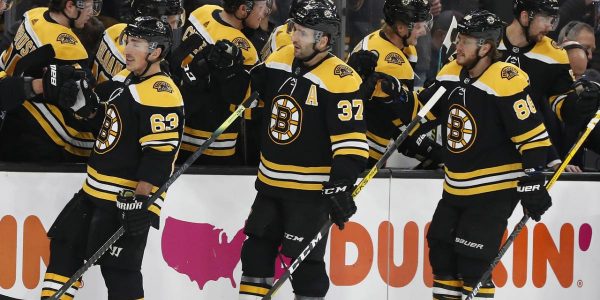
2021-22 Projection: 3rd place in the Atlantic Division
For Bruins fans, the 2021-22 season’s success or failure will be decided in the playoffs. No matter where they seed after 82 – this town cares about championships, not playoff births.
The Butch Cassidy era has proven successful by any measure. Since taking over in 2016-17 for franchise all-time wins leader Claude Julien midseason, the “Sundance Kids” immediately demonstrated a more fluid, creative, and dynamic team game when in possession of the puck – no matter the zone – without abandoning the generally excellent team defense of his predecessor. This formula has produced a bell curve of non-Stanley Cup success – Round 1 loss, Round 2 loss, Stanley Cup Finals loss, Round 3 loss, Round 2 loss. Following the natural progressions of most championship teams, this could be interpreted as a tell-tale sign that we missed our shot. Despite these trends, the Gallery God’s can hold out hope that the best is yet to come.
This year’s roster represents the biggest single-year turnover, perhaps in the Bergeron core’s era (~2008-pres). Last year’s deadline acquisitions Taylor Hall ($6Mx4y), Curtis Lazar ($800k expires end of the season), and Mike Reilly ($3Mx3y), have all been retained for this coming season. The deadline trio will be joined by newly signed bottom nine forwards Nick Foligno ($3.8Mx2y), Erik Haula ($2.375Mx2y), Tomas Nosek ($1.75x2y), and defenseman Derek Forbort ($3Mx4y).
Upfront, the forward group will once again be led by the Perfection Line of Pastrnak, Bergeron, and Marchand. The superstar threesome on below-market cap hits remains the critical factor in the Bruins’ “Cup contender” status. At 36 and in the final year of his contract ($6.87M), Patrice Bergeron will once again be asked to produce a point-per-game offensively while maintaining his perennial Selke Trophy quality shutdown matchups with opponents’ top lines. We never doubt Patrice but keep a close eye on whether he can continue to carry this workload as inevitable extension talks loom.
Brad Marchand has emerged as, without question, the best player on the team and truly one of the top players in the league. Marchand’s evolution can be very easily traced back to the coaching change from Julien to Cassidy. Kudos to Bruce for that.
David “Pasta” Pastrnak is as offensively gifted as almost any in the world. You must be able to accept a lesser defensive responsibility for a player of Pasta’s offensive understanding than you can for 63 and 37 – however, Pasta’s puck security and decision-making with the puck on his stick remains a weak spot even for such an elite point producer.
This trio will produce its points if healthy – which all three have been extremely blessed with to date. If the Bruins take the next step in the playoffs, they will need to see the same type of regular-season 5v5 dominance from the perfection line in the postseason.
It will be fascinating, and perhaps most critical to the team’s playoff aspirations, to see the chemistry of the second line (Coyle between Hall and Smith) develop through the season’s first months.
At this point, we should know what to expect from Hall and Smith. Taylor Hall should return to his point per game scoring pace thanks in large part to an anticipated boost in powerplay production. 5v5 Hall’s career track record is a mix. Many believe his passion to be part of this organization, best reflected by his below-market extension, as a sign that Hall is committed to winning a Cup.
Smith is a streaky scorer but one of the most consistent effort guys in the league. He fits in nicely with enough skill to produce what should be a ~50-point season (don’t expect a ton of PP minutes for Smith).
Charlie Coyle is a major X-factor for this season. Coyle’s career to date is what it is – a solid 200-foot center with good size, speed, and skill. From his days with the Minnesota Wild up through last season, Coyle has been a high-tier third-line Center. This season, with the departure of superstar David Krejci, Coyle is being asked to elevate his offensive game and playmaking. Hall’s dual shoot/pass threat, Smith’s gritty and consistent game seem to match well with Coyle’s puck possession game. This will be a telling year for Coyle’s $5.25M cap hit extension and whether that will prove to be a good or a bad contract for the club through 2026.
DeBrusk and Foligno are expected to be centered by Erik Haula on the third line. Haula is a stout Finnish centerman that Bruins fans should appreciate for his 200-foot, two-way game. I have long been a fan of Haula’s since he entered the league with the Wild as a meaningful role-playing contributor to some very tough playoff series. He has enough skill to sniff 40-plus points, but the production and effectiveness of his linemates will likely determine whether he comes close.
Jake DeBrusk has been personally very frustrating to watch for most of his four full NHL seasons as a pro. There is nothing “JD” can do to fight off the just criticism from the 2015 draft. What he can do, what is completely within his control, is choosing to be a more difficult player to play against. DeBrusk seems to think of himself as a highly-skilled scoring winger. Four years in that doesn’t seem to be the proper assessment. He has excellent speed and certainly enough skill to sniff twenty goals each year. His balls to the wall forechecks are all too often followed by “fly-bys” of defenders completely eligible to be hit but ignored by the decidedly “skilled” winger. If he cannot reverse his mentality on the ice and bring some better hockey IQ to his decision-making (puck movement, taking bad penalties), I hope the Bruins can find a trade partner for his $3.675M cap hit. Any extension talk with DeBrusk midseason will be concerning.
Foligno is a heart and soul player. The former Columbus Blue Jackets captain has every trait Bruins fans look for in a new acquisition: he is tough, intelligent, responsible, and eager to contribute however he can, including his willingness to drop the gloves. He should fit extremely well into the team’s dressing room and overall culture. On the ice, let’s hope his performance is more like early Backes than later years’ buy-out Backes. If it is the latter, the Bs could be reeling from another missed power forward UFA acquisition (Beleskey, Backes).
The expected fourth line could be an exciting new combination that proves useful beyond its combined cap hit (a modest $3.525M combined). Trent “Freddy” Frederic quickly became a household name for Bruins fans when he finally stood up to Capitals’ intimidator Tom Wilson early last season. Freddy has good size and more impressive toughness that combine with moderate skills akin to Looch from the early days – smart neutral zone passes, heavy forechecks that create o-zone chances, and strong possession of the puck down low with a no-fear mentality to drive the net. Keep offensive expectations low for Freddy, and the former first-round pick may just exceed them.
Nosek is clearly a tit for tat replacement of departed free agent Sean Kuraly. They are extremely comparable in almost every facet of the game. Nosek did see some top-line opportunities in high leverage situations during his time in Vegas, albeit largely due to injuries. Nosek has some upside to bring a bit more skill to 4L and will be an important penalty killer.
I really hope Karson Kuhlman gets a much-deserved fair shot at being an everyday player this year. As an undrafted player out of Minnesota-Duluth (where under his captaincy, they won back-to-back NCAA National Championships, I might add), Kuhlman has had to work for every opportunity he has received. He is an intelligent player with enough skill to play at the NHL level. If Kuhlman can have the chance to play every day, he is my preseason pick for the Bruins 7th player award.
On the blueline, most likely the greatest sore spot from last season’s playoff loss to the Islanders, it begins and ends with Charlie McAvoy. The 23-year-old has proven to be a legit #1 stud. McAvoy’s health is critical for this season’s success. I get less caught up in his point production than others because nowadays, regular powerplay time is often the difference between 40- and 60-point output. Not a lot to elaborate on for 73 beyond his health and pending contract extension – which will be massive even if he takes a hometown discount.
It is mildly justifying seeing the front office agree with me on Charlie’s health – best embodied by his new projected defense partner UFA Derek Forbert. Forbert’s s size (6’4″ 219lbs) and shared alumnus draw some comparisons to former LA Kings Stanley Cup champion Matt Greene (one of my personal all-time favorites). I am concerned about Forbert’s ability to play top-pairing minutes.
In fairness to Forbert, I have not seen a lot of him during his past six seasons in the Western Conference and just an 18-game playoff career. Let’s hope this old-school, shut-down, stay-at-home defenseman brings some much-needed snarl to the front of the Bruins’ crease and can keep footspeed with the top-end talent he’ll be tasked to defend playing alongside McAvoy. If Forbert is steady, we may see McAvoy’s ability to join the rush and play a more offensively inspiring game spike. That is undoubtedly the plan.
The second pairing of Mike Reilly and Brandon Carlo looks to be a good match on paper. Carlo, when healthy (!), has proven to be a legit number three defenseman with his smooth skating, strong positional play, and defensively alert stick. Reilly is a puck mover who should help the transition game from defense to offense.
I would be remiss not to elaborate on my significant concerns with Reilly. Last season I saw the deadline acquisition sparkle when given time and space, only to cower in the biggest playoff moments when opponents are most keen on putting him into the second row. Reilly’s game, to me, shows real fear of being hit. When opposing forechecks close in, Reilly can panic with the puck and put his teammates in compromising positions he wishes to avoid for himself. This is of particular concern due to Carlo’s concussion history. That dynamic makes this pairing yet another pivotal question mark that could be the difference between a legit Cup run and another playoff disappointment.
The bottom pair projects to be Connor Clifton and Matt Grzelcyk. While we may see Zboril sprinkled into the lineup from time to time, these two are the ideal combination.
Clifton has guts and plays an exciting brand of hockey, which is not always ideal for your bottom pairing. He moves the puck well and skates better. Clifton has grown popular with the fan base for his willingness and sometimes eagerness to make big open-ice hits. He’s never far from the action (good or bad), so his progress shouldn’t be hard to track for Bs fans this season.
Gryz is the type of player Bruins GM Don Sweeney (and even head coach Bruce Cassidy) thinks he was. There seems to be serious favoritism to Gryz for his similar style of play to that of the careers of the two-headed leadership. It’s hard not to like Gryz. He is as humble as anyone in pro sports. He makes the most of his talents. He has proven that he belongs in the NHL the hard way. My only concern with Gryz is how he manages defensively compromising positions his new blue line partner may put them in. If these combinations falter in the first few weeks, it wouldn’t be shocking to see Cassidy reshuffle Gryz up to McAvoy.
In net, the Bruins will enter their first season in twelve years without Tuukka Rask. While the fanbase is extremely polarized on Rask’s career, his consistent performance between the pipes was without question a cornerstone of the franchise’s perennial playoff births. The writing seemed to be on the wall for rookie Jeremy Swayman to take the torch in Tuukka’s absence.
However, the offseason signing of former Buffalo Sabre Linus Ullmark at a startling $5M AAV for the next four years very clearly defines the organization’s strategy in the net. Ullmark is being paid to be the #1, but in today’s NHL, you need a solid 1A too. Hopefully, Swayman can be that 1A and even contend to be the chosen netminder for postseason play. Ullmark struggled this preseason, but it is never fair to judge the preseason. Time will tell if his contract is good or bad. Both goaltenders have their question marks, but if both pan out, they could be a Jennings Trophy contending gruesome twosome.
These Bruins should be a shoo-in for the playoffs, and that is where their legacy will be cemented. Every championship team needs a combination of talent, grit, togetherness, goaltending, and some lucky breaks to hoist Lord Stanley. This year’s team certainly has the first three. I expect the lucky charms to be the missing ingredient in another emotional playoff run. Buckle up, Bs fans; it’s hockey season!
Toronto Maple Leafs (2020-21 35-15-7, 77 points, t5th in NHL)
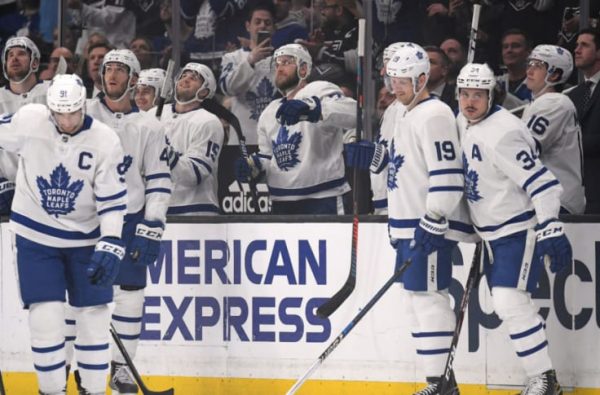
2021-22 Projection: 5th place in the Atlantic Division
Some may believe my 5th place projection for these Leafs to be a product of my own distaste for the organization, its structure, and the attention it garners among NHL media outlets, but I am digging in my heels with perhaps the “hottest take” of this division preview.
No fanbase is as acutely aware of the Maple Leafs’ playoff failures quite like ours. Last year was perhaps a new low. The Leafs beat upon its uniquely weak divisional opponents en route to an excellent regular season and a first-round matchup with the 25 to 1 Cup pretender Canadiens. After taking game one but losing captain John Tavares to a gruesome knockout collision, the Leafs eventually fell in seven games to the Habs. Despite Montreal’s run afterward, that loss said more to me about the Leafs than the Habs.
Toronto’s roster construction (top 4 forwards make up approximately half of the Salary Cap) has come under widespread criticism for multiple years now. Last season was supposed to be it. Do I think Auston Matthews lacks the guts to take over a playoff series like he ought to be capable of? Yes. Do I believe John Tavares lacks the leadership traits necessary for that of a Stanley Cup champion? Yes. Do I think the Leafs are a terrible team that isn’t built to make the playoffs? No, but I’m betting it will shake out that way. Here’s why…
Upfront Matthews / Marner / Tavares / Nylander will produce and do so proficiently. The offseason departure of Zach Hyman, to me, compounds with the loss of Nazim Kadri to truly exploit the biggest deficiency on this team – guts. Their forward group was soft last year (save for returning 33-year-old Wayne Simmonds) and is returning softer without Hyman (now an Oiler) and Jumbo Joe Thornton (now a Panther). The bottom six for Toronto is a major hole that looks like an excellent opportunity for needed support at the trade deadline – the problem is the Leafs don’t have any cap flexibility.
Their blueline looks to be solid but is centered around Morgan Rielly, who is entering a contract year in the biggest media spotlight, perhaps in the sport. Rielly and steady partner TJ Brodie are legit. The second pairing of Jake Muzzin and Justin Holl are an equally decent shutdown pair. The third pairing of 21-year-old Rasmus Sandin and 24-year-old Travis Dermott is where the Leafs would want to make an addition for a depth defender, but, again, they don’t have the cap space to do it.
In net, the Leafs are counting on another excellent season from Jack Campbell with 1A support from Peter Mrazek.
I expect the season to crumble right around the trade deadline when the front office and head coach, both with Cup or bust expectations, make some critical mistakes that doom the fortunes of the spotlight franchise for multiple years to come.
I am not saying they will trade Marner (mistake). I am not saying they will trade Nylander (probably the best contract of the top four). I am certain they won’t trade Captain John Tavares (they should but will not). But they will make a tough decision, and I am betting it won’t work out. Book your tee times for early April Leaf’s fans; I smell a delicious disaster.
Tampa Bay Lightning (2020-21 36-17-3, 75 points, 8th in NHL)
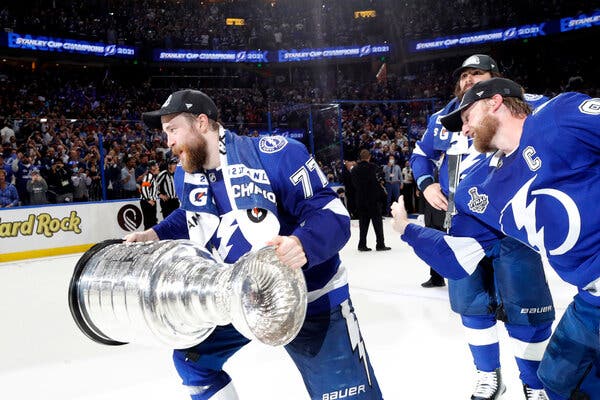
2021-22 Projection: 2nd place in the Atlantic Division
Everything that can be said for the Maple Leafs’ failed roster construction is equal and opposite to that of the Lightning. The returning back-to-back Cup champs have retained their proven, gutsy, well-rounded, worth-every-penny, Hall-of-Fame-quality core of Kucherov ($9.5M), Point ($9.5M), Vasilevskiy ($9.5M), Hedman ($7.875M). Yes, I did leave captain Steven Stamkos ($8.5M) off that list!
That group has the best defenseman in hockey (Hedman, 30), the best scoring winger (Kucherov, 28), a top-five center and perennial playoff standout (Point, 25) and the best goalie in the league (Vasilevskiy, 27). No matter what surrounds that group, they will be a threat every year until performance or health change drastically.
What is most different between Toronto and Tampa Bay is what surrounds that core. In one word: guts.
Alex Killorn is the definition of a glue guy on and off the ice. He clearly does a lot for their dressing room and culture. On the ice, he seamlessly fits into roles up and down the lineup with playmaking ability and elite hockey IQ in every situation, from the powerplay to the penalty kill.
Ondrej Palat is another not-quite-elite third-tier contributor. Palat could probably be a point per game player on other teams.
Anthony Cirelli is Tampa’s shutdown centerman that knows how to be challenging to play against and goes out to do it.
Speaking of being difficult to play against (Attn: Jake DeBrusk), the champs brought in Corey Perry to add even more sandpaper to their bottom-six alongside Patrick Maroon and Stanley Cup-clinching goal scorer Ross Colton – a fair-sized grinder that seems to be a long-term bottom-six fixture.
Mathieu Joseph, Pierre-Edouard Bellemare, and home-grown newcomer Taylor Raddysh round out the forward group.
These bottom six will have massive shoes to fill from the offseason departures of Blake Coleman (Calgary), Barclay Goodrow (NYR), and Yanni Gourde (Seattle). If the champs cannot make it three in a row for the first time since the 80s Islanders, it will most likely point back to that trio’s absence.
Defensively the Lightning are equally sick. That’s what is so frustrating! Hedman pairs with operational but less than impressive Jan Rutta, who has the easiest job on a cup contending NHL blue line since Chelios played with Lidstrom in 2002.
Ryan McDonagh and Erik Cernak make up arguably the league’s best shutdown pairing.
Mikhail Sergachev (hilariously traded straight up from the Habs for Drouin) and Zach Bogosian make up a more than effective third pairing most teams would feel great about as a second pairing. Keep an eye on former #14 pick from the 2017 draft Cal Foote, son of Adam, and whether he challenges Bogosian for nightly duties.
In net, Andrei Vasilevskiy is simply the best goalie going today, and it’s not even close. Veteran Brian Elliott will try to eat twenty-some-odd starts during the regular season, but there is no question who’s net it is at Amalie Arena.
The one pure similarity between the Lightning and the Maple Leafs is that neither team has any cap space whatsoever. It shouldn’t matter in Tampa, pending serious injuries and (gulp) more long-term IR cap maneuvering.
Head coach Jon Cooper strikes me as a bit of a smug know-it-all, but his players seem to love him, and his success speaks for itself. Cooper has learned the hard way how to manage the regular season and get his group ready for a run. Expect the same in the dog days of the season, and for that reason, I have the bolts coming in second.
The champs will be in the playoffs and will likely be the odds-on favorites to three-peat. I think that is an awful lot of hockey to play three years in a row, but it is undoubtedly tough to bet against them.
Florida Panthers (2020-21 37-14-5, 79 points, 4th in NHL)
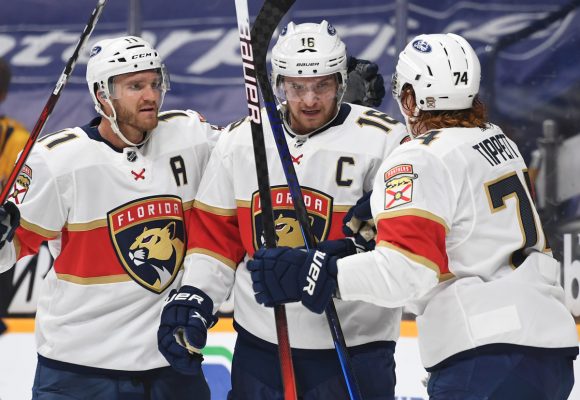
2021-22 Projection: 1st place in the Atlantic Division
Last season the Panthers gave the Lightning about all they could handle in an epic six-game series that had a very Gretzky Oilers to dynastic Islanders 1983 passing of the torch feel to it. Many interviews with players from that epic 1983 Finals point to the lessons learned by the young Oilers from the hardened Islander dynasty as the vital ingredient to the run that followed. Some readers may be channeling a bit of a Lee Corso “not so fast” to the above intro, but I am a serious buyer on the 2021-22 Panthers, despite their issues.
Their issues, to me, are outweighed by their untapped potential. In net, they have a $10M goalie in Sergei Bobrovsky that more likely than not will get bought out of his contract before its expiration after the 2025-26 season. To quote Seinfeld, “that’s a serious matzah ball.” However, the Panthers introduced former Boston College and US World Junior goaltender Spencer Knight during last year’s chaotic series with the champs. At just a $935k cap hit on his entry-level deal, the Panthers aren’t completely crippled by the Bobrovsky contract. The Panther’s fate will be determined in net. If Bobrovsky can return to form or Knight can channel some rookie Patrick Roy magic, the Panthers NOT, the Lightning may be the team to beat from Florida.
The other major untapped potential on this roster is 25-year-old former #1 overall pick defenseman, Aaron Ekblad. Ekblad suffered a season-ending knee injury that knocked him out of last year’s playoffs. If the Panthers are without their #1 defenseman again this year, not unlike the Bruins, they’re toast. Keep an eye on Ekblad and how he manages the regular season returning to Norris Trophy candidacy form.
The rest of the defense corps are a combination of great skaters and Radko Gudas. Sorry, Radko.
Brandon Montour is an explosive skater and gifted offensive defenseman. I am not the biggest fan of some of his puck handling and on-ice awareness in critical situations. He is 27 and should be figuring it out but keep an eye on whether he continues his progression or flattens this year. He is an important piece.
MacKenzie Weegar is a very similar player to Montour but with a much higher upside, in my opinion.
The redundancy of high-skill, speedy, offensive-minded defensemen is a good one to have in today’s NHL, but it may be the key gap between this year’s Panthers and a certain thirty-five-pound trophy.
The Panthers forward group is as good and as deep as any in the league. In combination with their offensively inclined blue line, scoring goals should not be an issue for these cats. Captain Aleksander Barkov, the reigning Selke Trophy award winner, is a Hall of Fame talent. Barkov is as positionally impressive as anyone in the league, but the skills he shows in every situation make an impact night in and night out.
Jonathan Huberdeau might be the most underrated player in the league now that the Big Cat (Barkov) is out of the bag. His vision really stands out, making not-obvious laser passes horizontally in the offensive zone. Huberdeau seems to have rounded out his three-zone game nicely, though there remains room for improvement. He will be an all-star and an Olympian for Team Canada, assuming he stays healthy.
The Panther’s depth forwards feels like the right mix of successful reclamation projects (Carter Verhaeghe, Frank Vatrano, Ryan Lomborg, Anthony Duclair) and seasoned playoff vets (Sam Bennett, Patric Hornqvist, Jumbo Joe Thornton). Verhaeghe emerged as a viable top-line option last year with high-end speed and enough finish to warrant his line mates.
Sam Reinhart, the former number-two pick in 2014, has shown he can score on bad teams in the NHL in Buffalo. This year will be a gigantic one for the 25-year-old carrying a $6.5M cap hit. If it isn’t, he may be heading back to a losing franchise around the deadline.
Patric Hornqvist is one of my favorite forwards in the league. Nobody works harder night in and night out than “Horny,” and if I do say so myself, his Florida tan just may inspire his nickname more so than his birth certificate.
Ryan Lomborg is a player that jumped off the screen in the playoffs. His energizer bunny game is contagious. Three-time Stanley Cup Champion head coach Joel Quenneville’s situational use of Lomborg all season (and particularly in the playoffs) will be an underrated key to this team’s consistency and the eventual division crown. Maybe, just maybe, this will be the year for Jumbo Joe Thornton to finally hoist The Cup.
Stay tuned for more updates from me throughout the Bruins season and perhaps an Olympic Hockey preview in February. Of course, keep coming back for continued coverage of your Boston Bruins all year from the BlackNGold Productions Team!


Ross Matthew’s articulate and insightful assessment of the 2021-22 Hockey Season is not only astute, but instructive…especially to those of us, myself, who need help connecting the dots. I want to read more from this guy!!! WELL DONE 👍